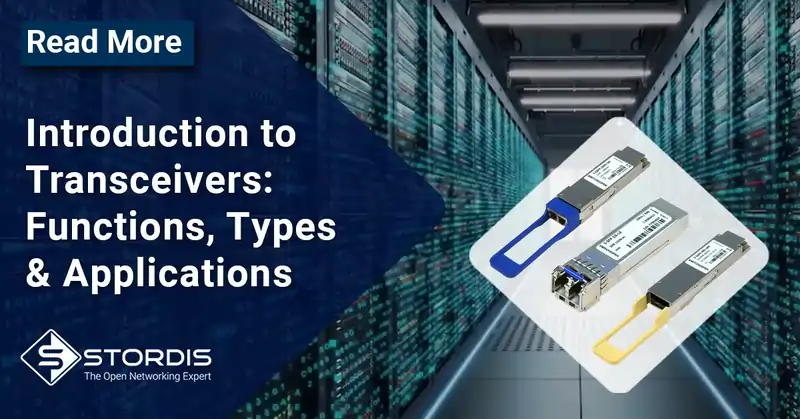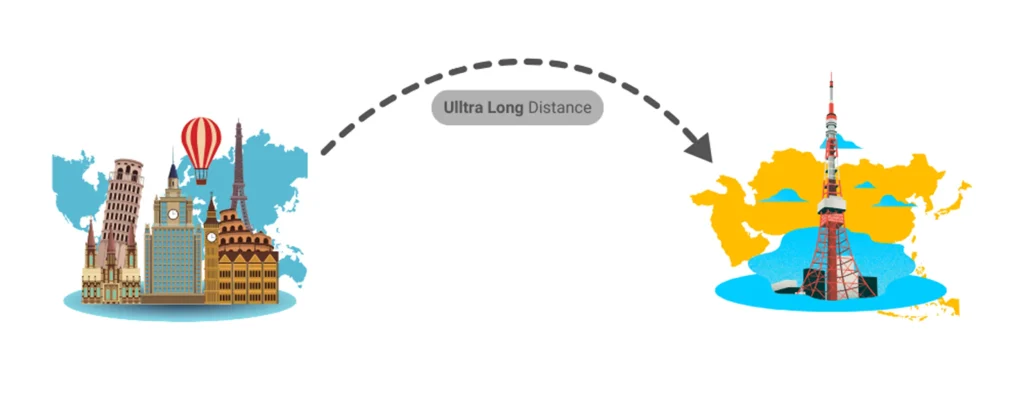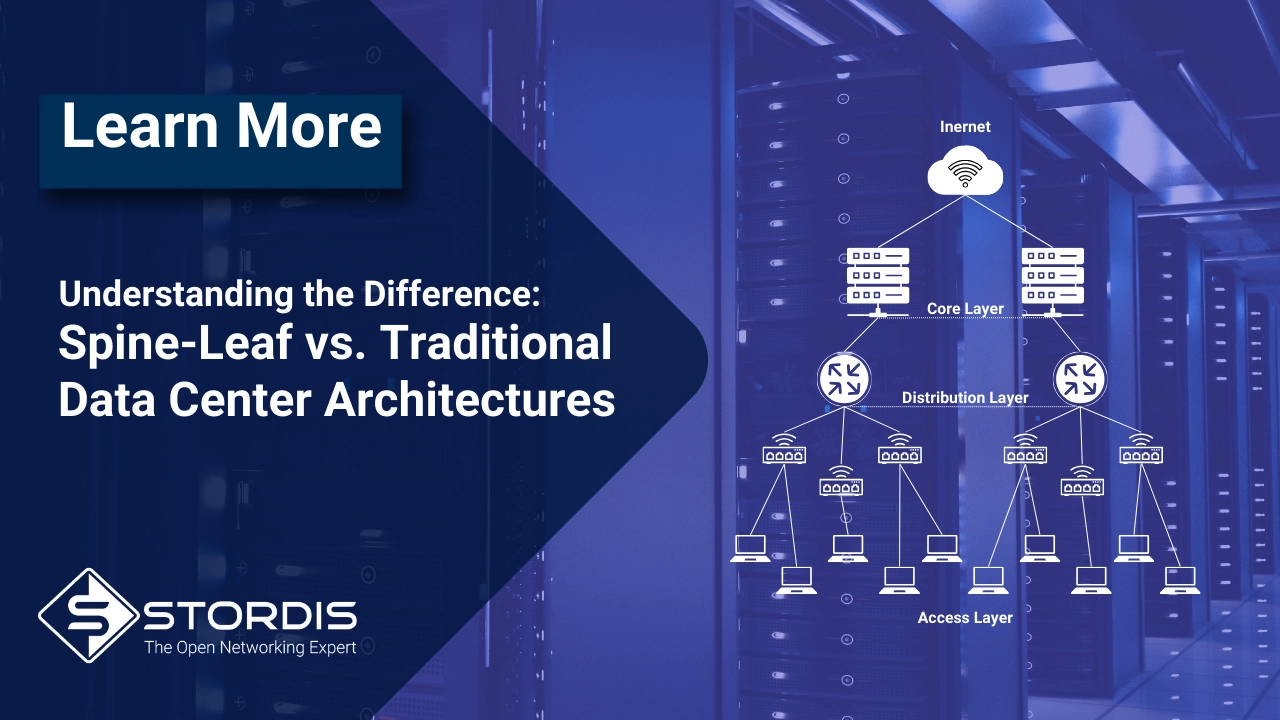- You have no items in your shopping cart
- Continue Shopping
Introduction to Transceivers: Functions, Types, and Applications

- What is the transceiver?
- How does transceiver work?
- Types of Transceivers: Gbps and Form Factors.
- Division of transceivers by connectors.
- Division of transceivers due to distance.
1. What is the transceiver?
A transceiver, short for transmitter-receiver, plays a pivotal role in modern networking by acting as an essential link between network devices. This compact yet sophisticated device serves as the intermediary between switches, routers, and cables, enabling seamless communication in various network setups.
Transceivers play a key role in modern communications ecosystems. Their importance extends far beyond fiber-optic networks; they are essential components in countless systems, including radio networks and Ethernet connections.
In radio systems, transceivers make the smooth exchange of wireless signals, enabling everything from cell phones to satellite communications. Similarly, in Ethernet networks, transceivers serve as essential interface devices, ensuring the fluid flow of data between various network components. Their universality is an certificate to their importance, making them fundamental not only to the field of fiber optic networks, but also to the wide range of communications technologies that power our connected world.
History of transceivers:
The beginning of the exploration of transmitter-receiver dives deeper into the complex of communications technology. From the basic telegraph systems of yesteryear to the state-of-the-art high-speed transmitter-receivers of today, the evolution is a statement of constant innovation. The first transceivers were analog and was working in simple telegraph systems or radio equipment. Many years transceivers were evolving and evolving and first optical transceiver were developed id the end of XX century.
The development of optical transceivers since the advent of the GBIC (Gigabit Interface Converter), in 1995, standard was a real breakthrough in optical communications. The GBIC, while revolutionary in its time, was relatively large and had limited data transmission capabilities compared to today’s standards. Over time, more advanced forms of transceivers appeared, such as SFP (Small Form-factor Pluggable) in early 2000, which were much smaller and allowed for higher port density in network devices. With the development of fiber-optic technology, SFP transceivers could transmit data over distances of up to several hundred kilometers, with minimal signal loss. The next milestone was XFP (10-Gigabit Small Form-factor Pluggable), which provided much higher transmission speeds, surpassing even 10 Gbps. XFP also made it possible to transmit data over longer distances, which was crucial in growing telecommunications networks. The evolution continued with QSFP28, which allowed data transfer at 100 Gbps. This standard was crucial in expanding data centers and telecommunications networks, where massive amounts of data required fast and reliable connections. The latest milestone is QSFP-DD, which supports speeds from 200 Gbps to as much as 800 Gbps. With double the number of channels, QSFP-DD delivers unprecedented speeds to support even the most demanding applications in today’s networks.
The journey from the SFP standard to QSFP-DD is a story of the continuing effort to make data transmission faster and more efficient. It’s also a testimony to the telecommunications industry’s continued efforts to respond to the growing demand for bandwidth in the digital communications age.
Key Functions:
Transceivers are akin to adapters, offering remarkable flexibility in network configurations. In the absence of transceivers, network devices would be restricted to connecting with only one type of cable. These ingenious devices empower network administrators with the freedom to select specific fiber or copper interfaces tailored to the unique requirements of their switches, routers, and other networking equipment.
Transmitting and Receiving Signals:
A transceiver is designed to both transmit and receive signals, making it a dual-purpose component in network communication. In the context of fiber-optic transceivers, they perform a crucial task: converting electrical signals into optical signals for transmission and transforming received optical signals back into electrical signals for processing. The transmitter (tx) emits light, utilizing either a laser or an LED diode, which travels as an optical signal over the network medium. On the other end, the receiver (rx) is equipped with a diode (detector) that captures the incoming optical signal and converts it back into an electrical signal, ensuring seamless data transfer.
Versatility and Advancements:
With advancements in technology, transceivers have become increasingly versatile. They support various data rates, transmission distances, and connector types, catering to the diverse needs of modern networks. Whether it’s a high-speed data center or a long-range telecommunications network, transceivers can be tailored to meet specific demands, making them indispensable components in today’s interconnected world.
In summary, transceivers serve as the backbone of network connectivity, providing the adaptability and functionality necessary for building efficient and high-performing networks. Their ability to bridge different network components while transmitting and receiving data ensures the smooth flow of information, making them indispensable tools in the realm of networking.
Optical Transceiver Applications:
Data Centers:
Optical transceivers play a key role in data centers, enabling extremely fast data transmission and data replication, ensuring security and reliability in large-scale data processing.
Telecommunications:
In the field of telecommunications, optical transceivers are a key component, connecting various telecommunications nodes. Their role is to provide stable and efficient connections in mobile and fixed networks.
Consumer Electronics:
Optical transceivers have found their place in consumer electronics devices such as Wi-Fi routers. They enable high-speed data transmission in devices such as routers, providing performance in home and office wireless networks.
Satellite and Radio Communications:
In satellite and radio communications, where fiber optics are not always available, optical transceivers play an important role. They allow stable communications in environments where traditional fiber optics are not practical or feasible.
2. How Does a Transceiver Work?
A transceiver operates as a vital bridge between electrical and optical signals, enabling seamless data transmission through fiber optic cables.
Transmitter:
The process initiates when a network device, such as a switch or router, sends an electrical signal to the transceiver. Within the transceiver, a laser diode or LED emits light when stimulated by an electrical current. This emitted light is meticulously controlled and modulated, allowing digital information to be encoded into an optical signal. The modulation alters the intensity of the emitted light, effectively encoding the digital data (represented as 0s and 1s) into the optical signal. This precisely modulated optical signal is then transmitted through Fiber Optic Cable.
Receiver:
At the receiving end, another transceiver or a photodiode detects the incoming optical signal. The photodiode absorbs the incoming light, liberating electrons in the process and generating an electrical current. This current faithfully represents the original data. Subsequently, this data is transmitted to the receiving device, such as a server, ensuring the seamless flow of information.
In essence, a transceiver’s ability to convert signals between electrical and optical forms facilitates high-speed and reliable data communication, making it a fundamental component in modern networking systems.

3. Types of Transceivers: Gbps and Form Factors:
Form factors in transceivers are important due to their impact on network density, connectivity, and speed. Different types of form factors enable different port density, ensuring more transceivers fit into limited spaces. They also determine connector types, ensuring compatibility. Form factors determinate speed of transceivers, meeting the demands of modern applications. Adapting to these changes ensures efficient, high-speed data transmission in evolving networks.
SFP
SFP, which stands for Small Form Factor Pluggable, represents a remarkable advancement in networking technology, offering versatile solutions for high-speed data transmission across varying distances.
IEEE Standards and Variants: Within the realm of SFP transceivers, the IEEE Standard Association has defined specific standards to cater to diverse networking needs:
1000BASE-T: This standard defines a short-distance range of up to 100m, utilizing an RJ45 copper port for connectivity.
1000BASE-SX: Designed for multimode SFPs, this standard supports distances of up to 550m and operates at a wavelength of 850nm, ensuring efficient short-range transmission.
1000BASE-LX: Tailored for singlemode SFPs, this standard extends the range to an impressive 10km, operating at a wavelength of 1310nm. It’s ideal for applications requiring longer connections. 1000BASE-EX: For singlemode SFPs demanding even greater reach, this standard supports distances of up to 40km at a wavelength of 1310nm, enabling reliable data transmission over extensive distances.
1000BASE-ZX: This standard pushes the boundaries of connectivity, reaching distances of up to 80km at a wavelength of 1550nm. It’s the go-to choice for ultra-long-range applications, ensuring seamless communication over vast distances.
BiDi SFP: Bi-Directional SFPs revolutionize fiber optics by enabling bidirectional transmission over a single fiber. Two BiDi SFP transceivers, connected via a fiber link, must share the same wavelength to establish a successful connection, enhancing the efficiency of fiber-optic networks.
Incorporating these diverse SFP standards into network setups ensures the smooth flow of data, regardless of the distance, making them indispensable components in modern networking infrastructures.
SFP Transceivers: Diverse Classes, Enhanced Capabilities SFP transceivers are categorized into three distinct classes: SFP, SFP+, and SFP28.
SFP+:
This enhanced version of SFP supports 8 Gbit/s Fiber Channel and 10 Gigabit Ethernet, providing robust connectivity options for high-speed data transmission.
SFP28:
Representing an upgrade from SFP+, SFP28 maintains the common form factor while supporting an impressive 25 Gbps on a single channel, ensuring swift and reliable data transfer in high-performance networking environments.
QSFP
QSFP Transceivers: Unleashing High-Speed Connectivity
QSFP, an acronym for Quad Small Form-factor Pluggable, represents a pinnacle in high-speed data transmission, supporting remarkable data rates of up to 100Gb/s per channel. This exceptional capability positions QSFP transceivers as vital components in the heart of data centers and high-performance computing environments. What sets QSFP apart is its ability to handle data at speeds four times that of corresponding SFP modules, making it a preferred choice for applications demanding lightning-fast data communication.
Key Attributes of QSFP Transceivers:
Four Channels of Speed:
QSFP transceivers possess the extraordinary capacity of four channels, both for receiving and transmitting data. This innovative design allows for unparalleled speeds, ensuring seamless data flow in the most demanding network setups.
Versatility in Standards:
QSFP modules are incredibly versatile, supporting a multitude of data communication standards. This adaptability makes them indispensable in a variety of networking scenarios, ensuring compatibility with diverse systems and protocols.
QSFP Classes: Elevating Connectivity Standards
Within the QSFP family, three distinct classes cater to diverse networking needs:
QSFP:
The foundational QSFP class lays the groundwork for high-speed data transmission, providing a robust foundation for rapid information exchange in sophisticated networks.
QSFP+:
Building on the QSFP legacy, QSFP+ introduces the concept of four channels operating at 10Gb/s each. These channels can seamlessly merge into a single 40Gb/s Ethernet link, amplifying data transmission capabilities.
QSFP28:
Representing the pinnacle of QSFP evolution, QSFP28 modules harness the power of four transmission channels, each operating at an impressive 25 Gbit/s. This architecture delivers a staggering total
In essence, QSFP transceivers redefine the boundaries of data transmission, providing the foundation for robust, high-speed connectivity solutions in the ever-evolving landscape of modern technology.
QSFP56:
Stand for Quad Form Factor 56. QSFP56 introduces the concept of four channels operating at 50Gb/s each.
These channels can seamlessly merge into a single 200Gb/s.
QSFP-DD 400G:
Stand for Quad Small Form Factor Pluggable Double Density. QSFP-DD introduces the concept of eight channels operating at 50Gb/s each. These channels can seamlessly merge into a single 400Gb/s
OSFP-400G:
Standard called Octal Small Form-factor Pluggable which has eight high speed lanes that support 400 Gbps.
QSFP-DD 800G:
Quad Small Form-factor Pluggable Double Density Multi Source Agreement standard was designed for high-speed (up to 800Gb/s) data rates and it’s focused on next generation of the QSFP modules.
OSFP 800G:
Standard called Octal Small Form-factor Pluggable Multi-Source Agreement’s designated for data center application up to 800Gb/s on a single channel. Standards like this is a key in advancing networking technologies and allows to rapid and reliable data transmission in developing network environment.
As you can see in below table SFP… and QSFP transceivers have different sizes so they are not compatible with each other
| Type | Dimensions |
| SFP | 8,5 x 13,4 x 56,5 mm |
| SFP+ | 8,5 x 13,4 x 56,5 mm |
| SFP28 | 8,5 x 13,4 x 56,5 mm |
| QSFP | 8,5 x 18,5 x 72 mm |
| QSFP+ | 8,5 x 18,5 x 72 mm |
| QSFP28 | 8,5 x 18,5 x 72 mm |
4. Division of transceivers by connectors.
Transceivers use different types of connectors to make connections to fiber optic cables. Here are some of the common connector types used in transceivers:
ST connector
ST connectors (Straight Tip connector) are very simple and easy of use. These connectors have a bayonet connection mechanism and a long cylindrical sleeve that holds the fiber optic cable.
ST connectors are being replaced by LC and SC connectors, which has higher port density and are smaller.
FC connector
FC connectors (Fiber connector) is coupler with threaded body which was designed to use in high vibration environments. FC connectors are well know due to their durability and stability of fiber optics connection.
LC connector
LC connectors are widely used in transceivers due to their compact size and efficient duplex configuration, making them suitable for high-density applications in data centers and enterprise networks. They have push-pull mechanisms.

RJ45 connector
RJ45 connectors are widely used in Ethernet networking for connecting devices such as computers, switches, routers, and other network equipment. They are used with Ethernet cables to establish wired network connections. RJ45 connectors are not used with fiber optic transceivers directly because transceivers that work with fiber optics use specific fiber optic connectors like LC, SC, MTP/MPO, etc. RJ45 connectors are designed for copper-based Ethernet connections and are used with transceivers that operate over copper cables, such as those supporting 1000BASE-T Ethernet standards.

SC connector
SC connectors are commonly used in transceivers and network equipment, especially in older installations. They have latch mechanism for secure connection.
MTP/MPO connector
MTP/MPO connectors are used in transceivers and network applications where high-density connections are required, such as in data centers for high-speed networks. They have push-pull mechanisms.

5. Division of transceivers due to distance.
Categories of Transceivers on the Basis of Range:
Short Range Transceivers:
Short-range transceivers are designed for efficient communication over relatively short distances, such as rooms in a single building or data centers. They are ideal for fast data exchange within a single location, providing efficient connectivity between devices in the same space.

Long Range Transceivers:
Long-range transceivers are designed to cover longer distances, such as connections between different buildings or even cities. Their advanced features allow them to connect separate locations, enabling continuous data exchange over long distances, which is especially important in urban or regional environments.

Ultra-Long Range Transceivers:
Ultra-Long Long Range Transceivers are designed for extended distance data transmission even through transcontinental or transoceanic communications. An example of an application is undersea cable, where data are traveling oceans.
Thus, in the world of communications, short- and long-range transceivers are key tools that adapt to different distance requirements. They give flexibility in network design, ensuring reliable and efficient connections, regardless of the space to be covered.

Check transceivers in action and discover the perfect match for your needs right here: https://stordis.com/product-category/transceivers-and-cables/transceivers/

Marianna recently completed her master’s degree in Production Management and Engineering, which she has added to her degree in Technical Physics. It is this passion for technology that allows Marianna to thrive in the dynamic IT environment at STORDIS and to ensure that our clients’ needs are not just met, but surpassed, with the highest standards of excellence.
Comments
You might be interested in








1 Comment
This is really useful simplified description about the transceivers that I have seen until now at least for those who are new to semiconductor industry. It covers almost all the aspects of it.
Thank you for the incredible work.
Contact us if you need a bonding machine for transceiver assembly.